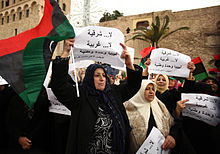This article has multiple issues. Please help improve it or discuss these issues on the talk page. (Learn how and when to remove these messages)
|
 Female protestors in Tripoli protest against calls to separate the country into three autonomous regions (March 2012). | |
| General Statistics | |
|---|---|
| Maternal mortality (per 100,000) | 72 (2020) |
| Women in parliament | 14% (2021) |
| Women over 25 with secondary education | 55.6% (2010) |
| Women in labour force | 34% (2019) |
| Gender Inequality Index[1] | |
| Value | 0.259 (2021) |
| Rank | 61st out of 191 |
| Global Gender Gap Index | |
| Value | NR (2012) |
| Rank | NR |
| Part of a series on |
| Women in society |
|---|
 |
The overall status of women in Libya has improved since the efforts of the Gaddafi government in the 1969 revolution.[2] The same government has been held responsible for various human rights violations, including on women.[3][4]Equal pay for equal work, universal healthcare, and the right to education have become state policy. Women have gained the right to vote, run for political office, and participate in national institutions. However, cultural biases against women in the workplace and resistance to change from traditional sectors of society have posed obstacles to process. Moreover, the political upheaval of the 2011 revolution has led to both gains and setbacks for women's rights. Nonetheless, the continued involvement and engagement of women in public life and government have emphasized the importance of female emancipation for the progress and development of Libya as a whole.
- ^ "Human Development Report 2021/2022" (PDF). HUMAN DEVELOPMENT REPORTS. Retrieved 13 December 2022.
- ^ Azzuz, Intisar S. Toperich and Mullins (ed.). A New Paradigm: Perspectives on the Changing Mediterranean (PDF). Center For Transatlantic Relations. pp. 149–159.
- ^ "Libyan Women and Political Participation: Ten Years Since the Revolution". Retrieved 2023-05-22.
- ^ "UN in Libya statement on "International Day for the elimination of sexual violence in conflict zones" - Libya | ReliefWeb". reliefweb.int. 2020-06-20. Retrieved 2023-05-22.
